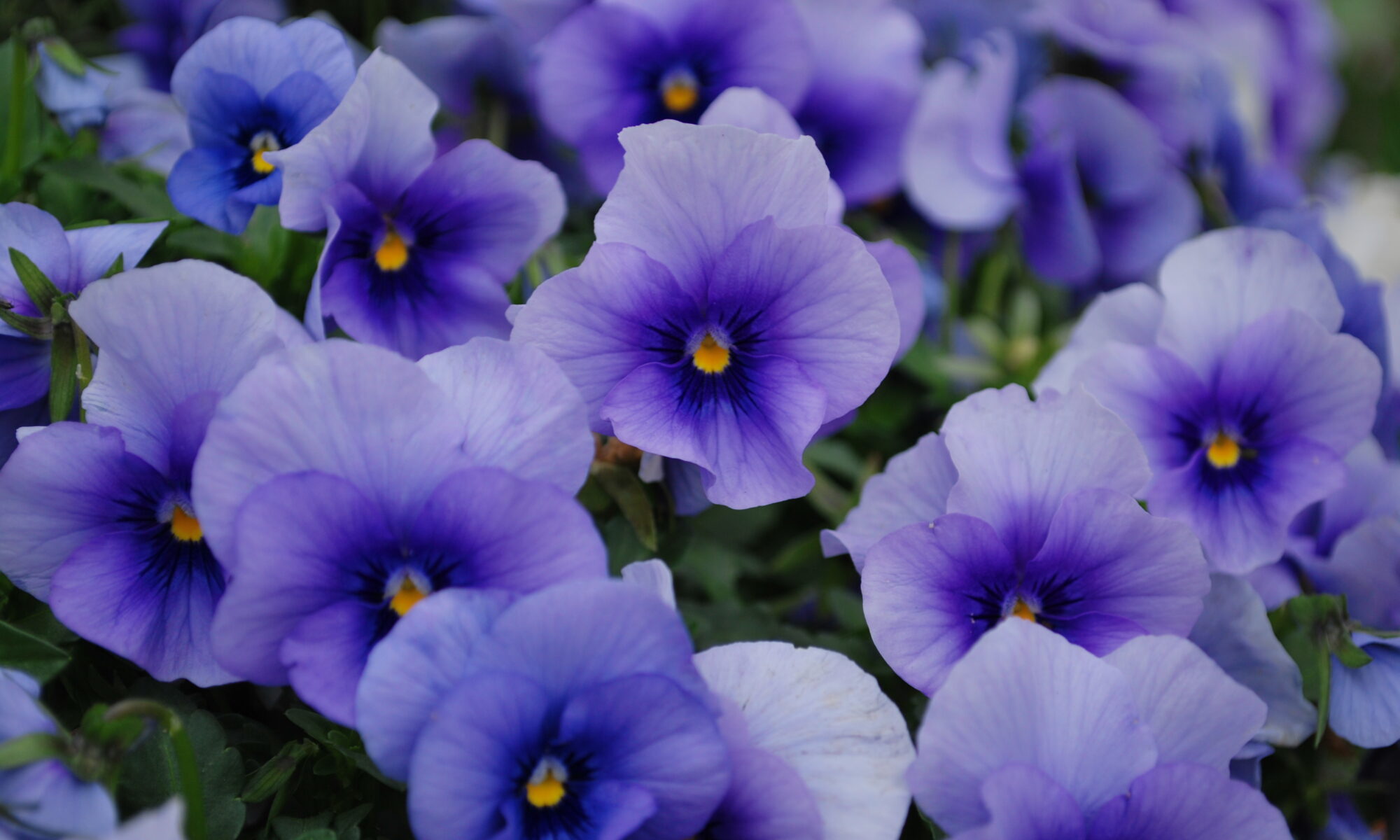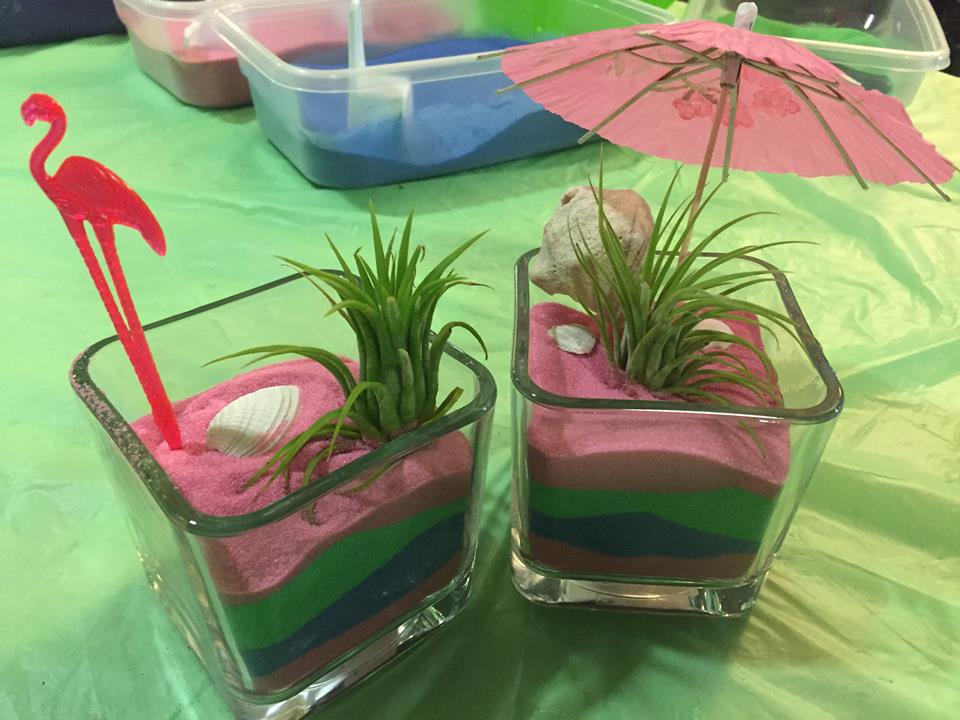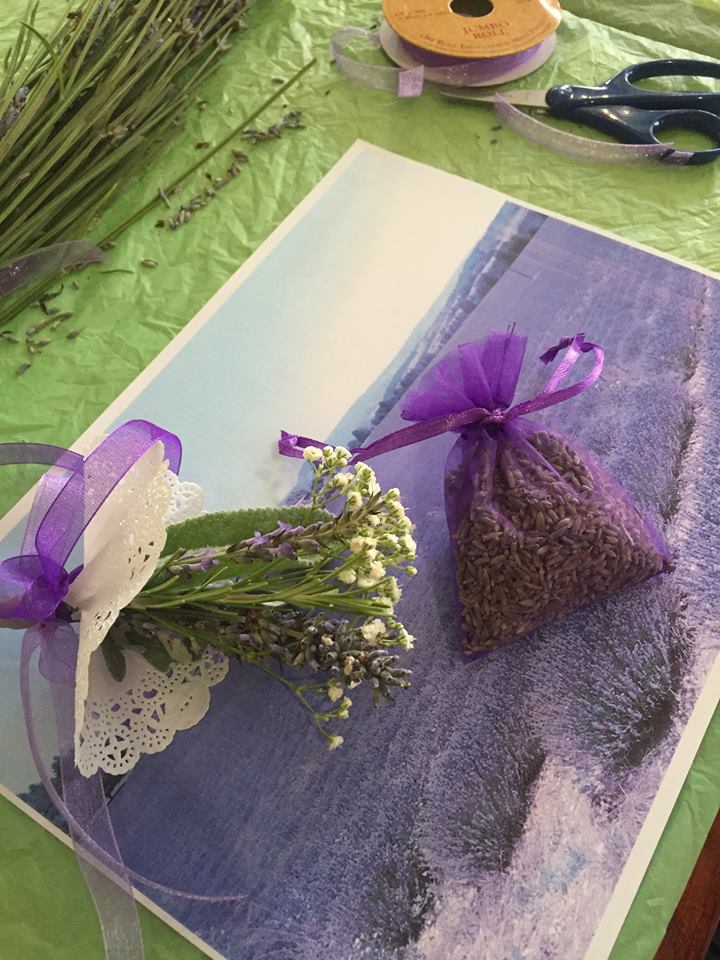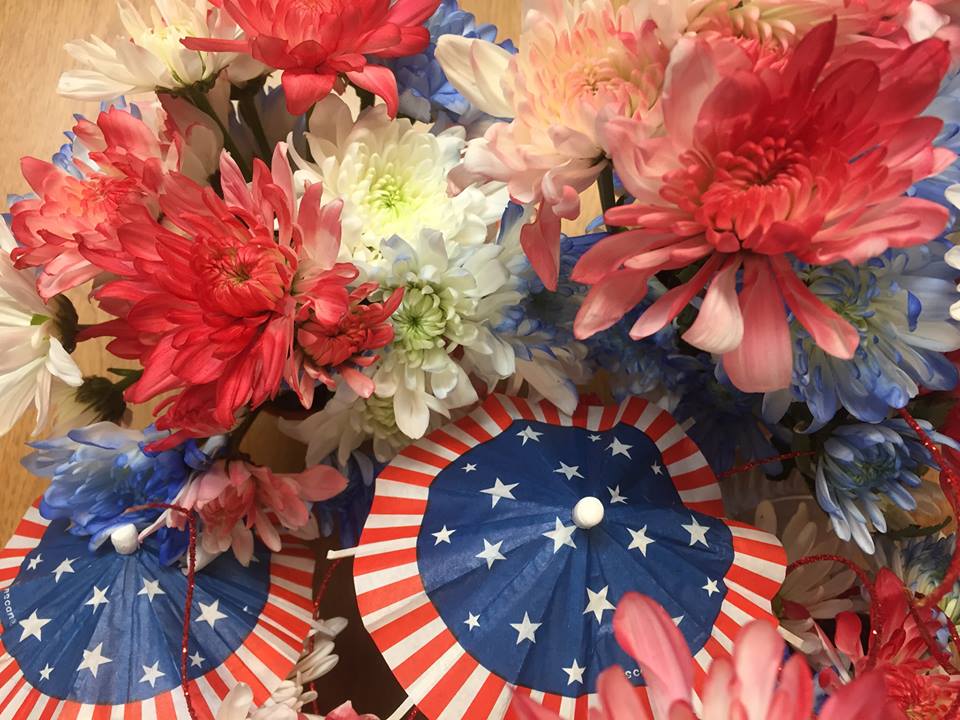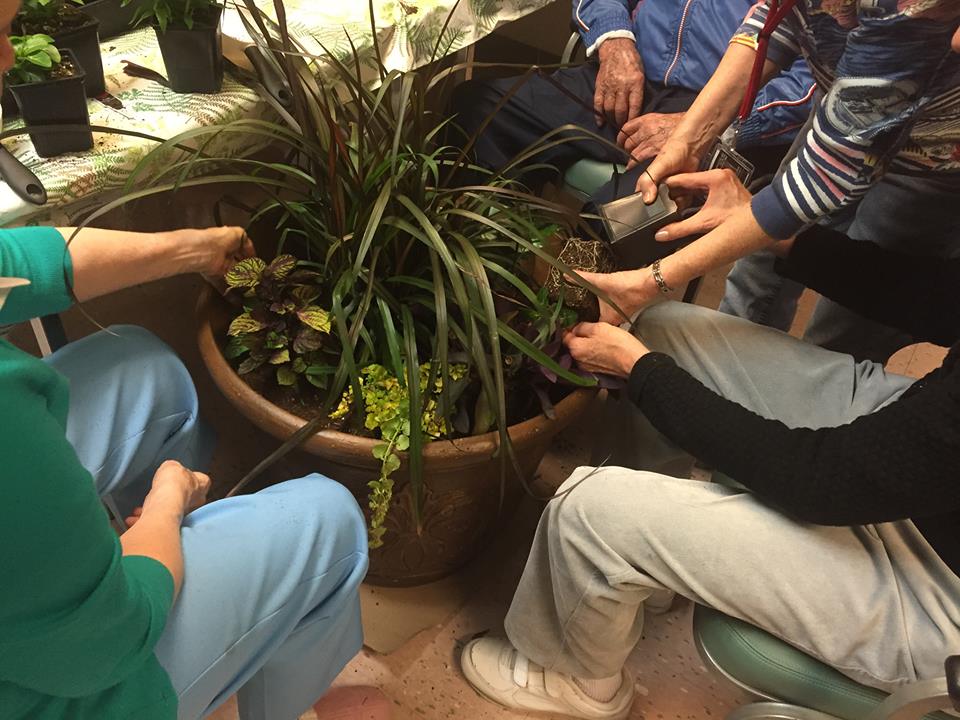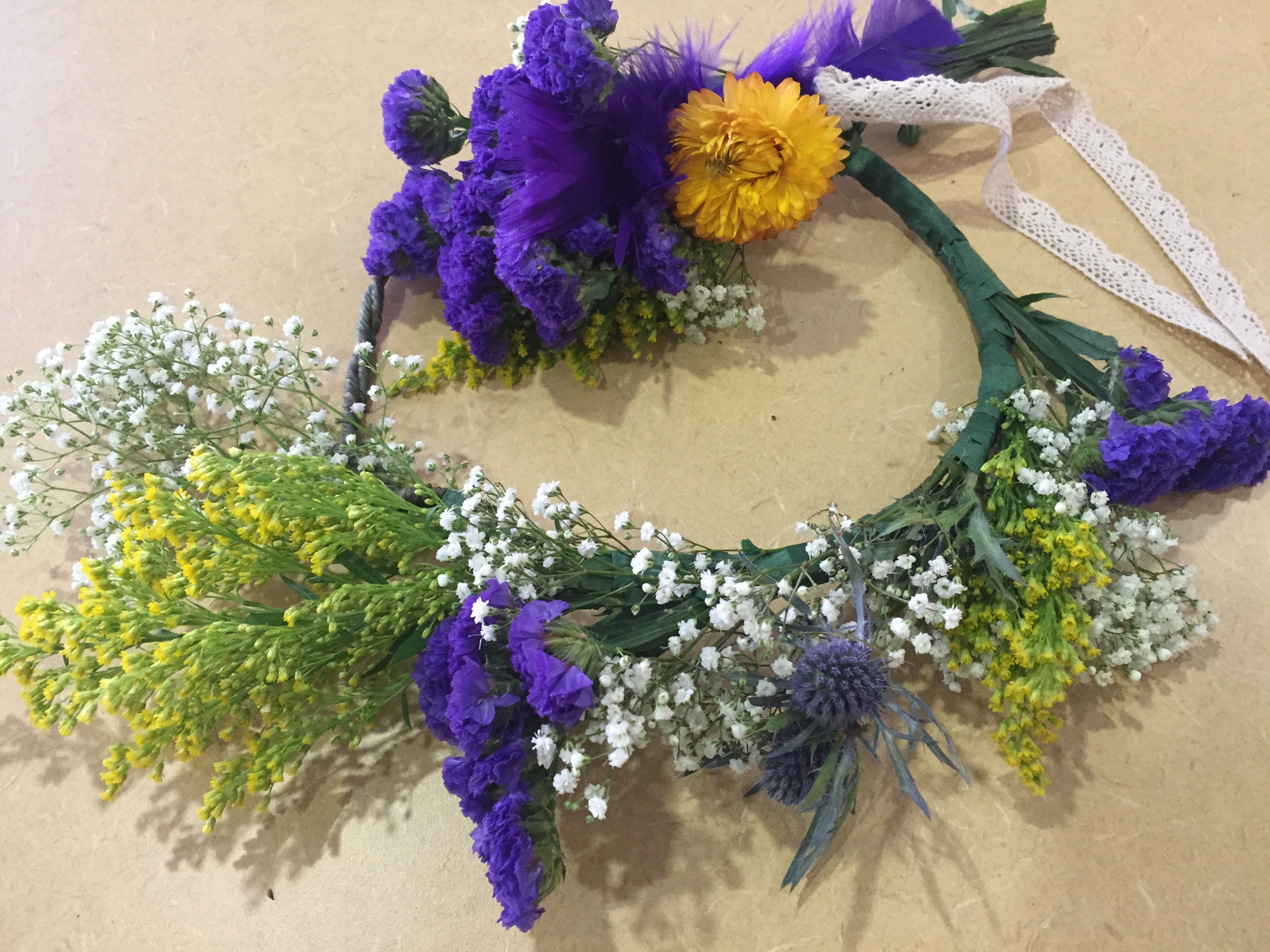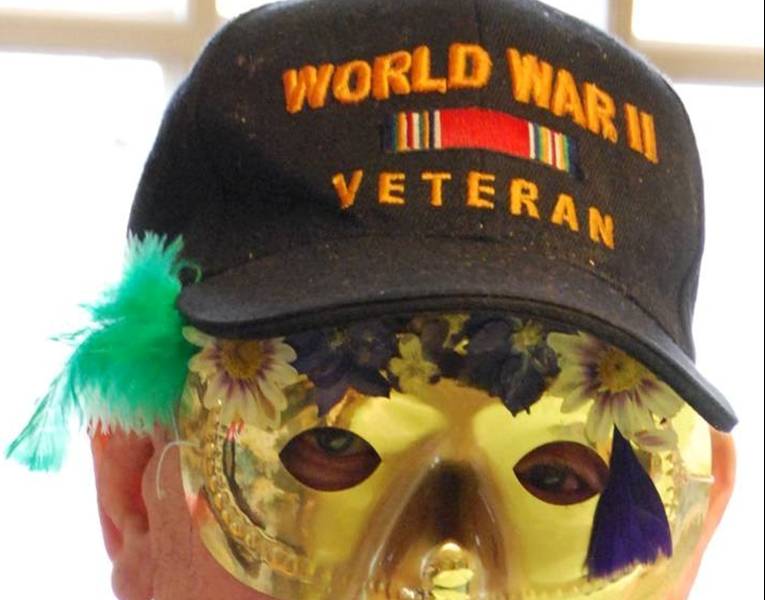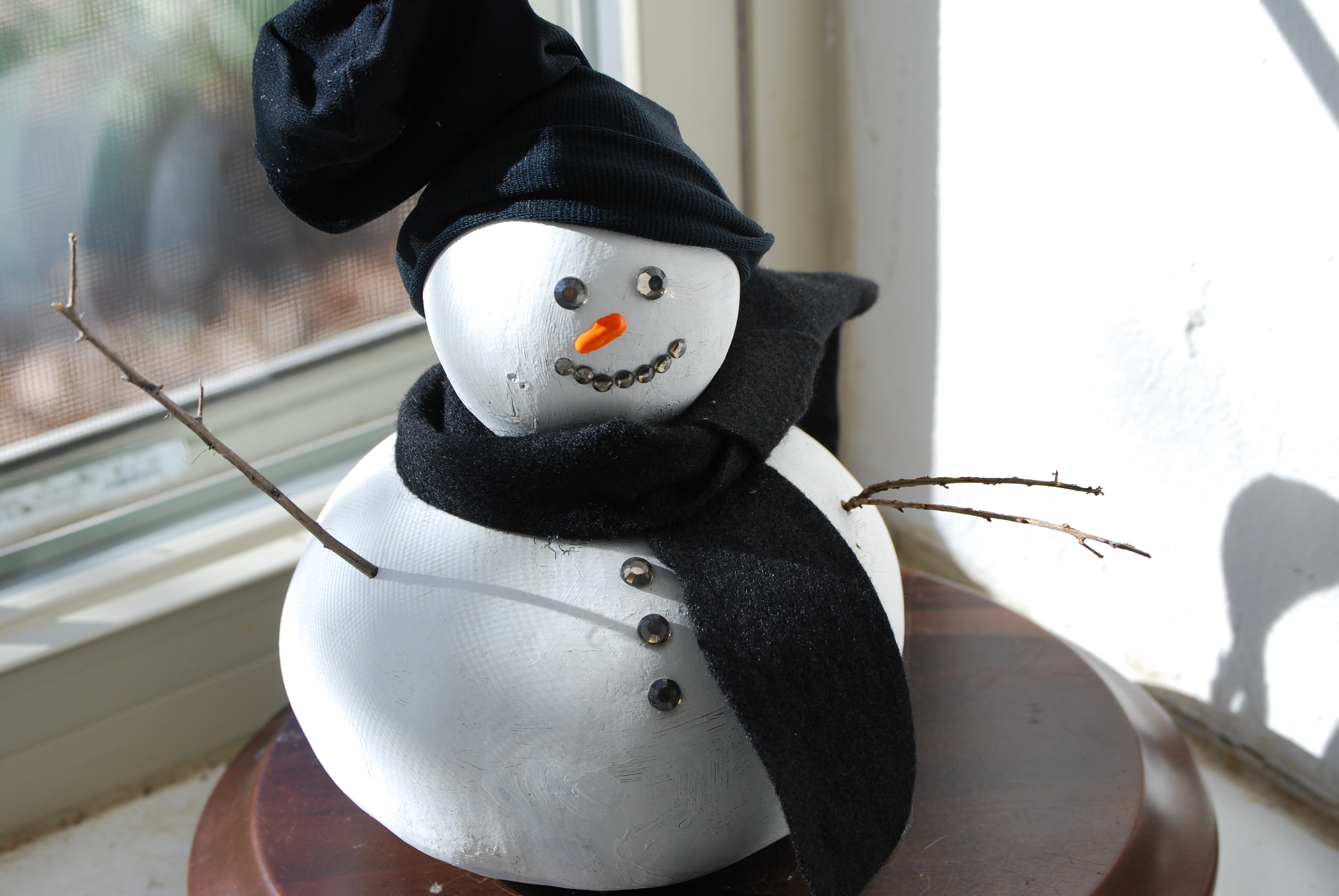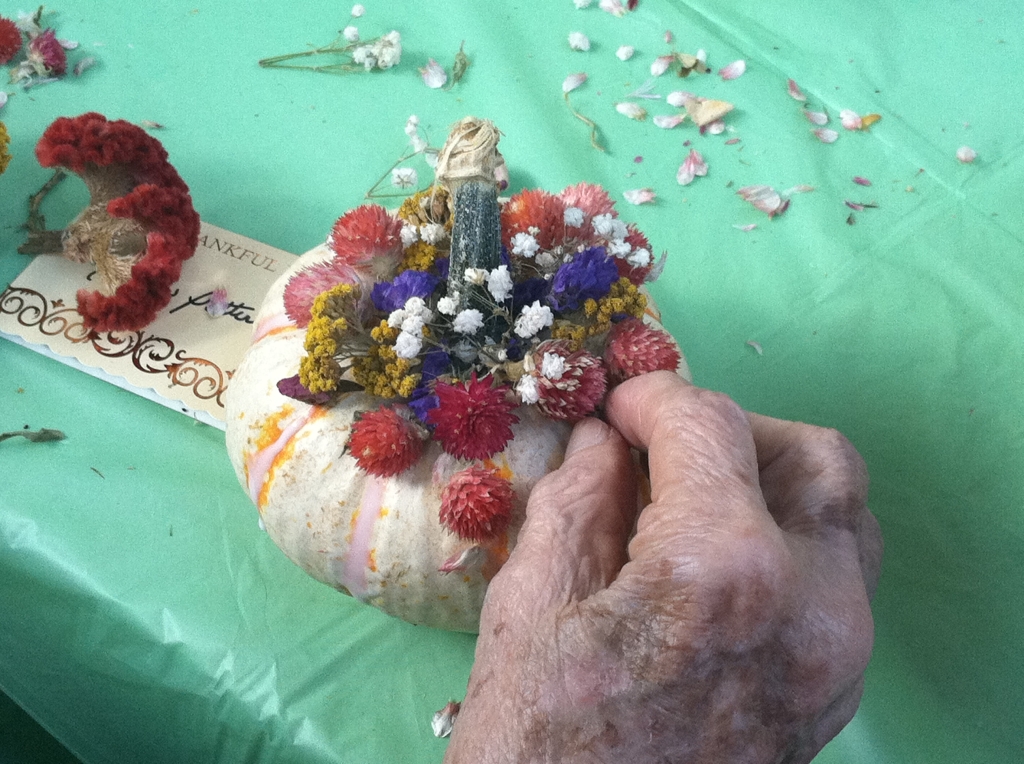A Summer of Therapeutic Horticulture Activities
Whew, it’s a scorcher! Check out a few therapeutic horticulture activities that have kept my clients active this summer, in spite of the heat.
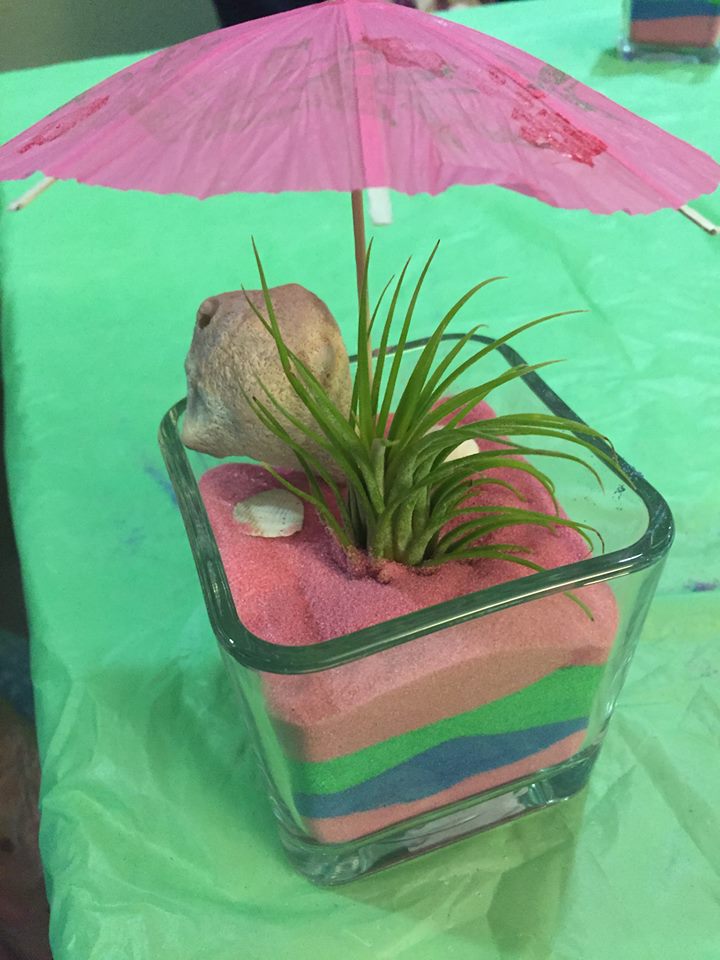 A Day at the Beach – Colorful Sand Art Cubes
A Day at the Beach – Colorful Sand Art Cubes
Clients apply layers and layers of colored sand into glass cubes. Then add a Tillandsia (or a succulent plant) to the cube. I always like to give clients an additional option to embellish their work and put the proverbial “cherry on top” – here, a pink flamingo, beach umbrella pick, and/or seashell. We talked about and passed around photos of beach imagery, listened to the “ocean” in a conch shell, examined sand dollars and seashells, passed around cuttings of tropical plants that grow in our climate, and even played in the sand and water for a little bit.
I like to take interesting plants that are “in season” and develop out an activity focused entirely on that plant. In this case, it’s all about lavender. Participants learned about the history, use, and benefits of lavender. (Insert deep breath here. Now don’t you feel relaxed?) We passed around photos of a lavender field in Provence, applied cotton swabs of lavender essential oil to the pulse points (wrist), compared the fragrances of dried versus fresh English lavender, and did a brief meditation exercise. I even brought in various products that incorporate lavender. We had a chuckle over Secret’s Clinical Strength “Ooh-La-La Lavender Scent” Deodorant. Participants then made lavender sachets and Tussie Mussie corsages with lavender and other material cut from the garden.
For Independence Day, we compared the explosions of fireworks to the structure of different flowers. Can you see the similarities? Participants discussed Hanabi (Japanese term – “hana” means “flower” & “bi” means “fire” – compare to flower viewing festival Hanami and the Japanese language of flowers Hanakotoba), then we discussed our traditions of Fourth of July celebrations. Incorporate the 5 senses in this discussion – Sight: fireworks / Smell: burgers on the grill / Taste: watermelon / Touch: swimming in the pool / Sound: patriotic songs played by the marching band in the local parade. We even played some random trivia questions about the history and fun facts of fireworks. Then the group made floral arrangements with white daisies and poms painted with red and blue floral paint. Add an embellishment of star stickers, buddy bows, or patriotic picks. (For inspiration, check out the Flowerworks photographic collection of Sarah Illenberger – who studied firework patterns and then collected and took beautiful photos of a variety of flowers that resembled those patterns.)
Use basic woodworking skills and recycled pallet wood to assemble planters. Plant with herbs or easy-to-grow houseplants. Personalize with stenciling, paint, or hot-glued clothespins for displaying plant tags.
Container gardening provides opportunities to garden in small spaces or locations where finances, manpower, and space are limited, as well as experiment with interesting plants, enhance existing garden features, develop additional programming, and much more. Can’t bring your group outdoors? Bring the outdoors in! Put lightweight outdoor containers on wheels and bring them indoors for planting in hot climates or working with clients who are sensitive to heat or sun. This is how we were able to plant containers during our unexpected rainy “monsoon season” in late spring. When containers are planted, wheel them back outside, water, and watch ’em grow. (Yes, even the most drought tolerant plants require ongoing maintenance, so make sure you have clients willing to help with upkeep.)
More Therapeutic Horticulture Programming Ideas for Spring
A Sampling of Spring Therapeutic Horticulture Programming
Valentine’s Floral Arrangements
Conversation Heart Floral Arrangements
Gourd Snowmen
Mini Blooming Pumpkins
Miniature orbs decorated with dried flowers…how fantastically “fall!” If you’re looking for some no-carve, no-Halloween, pro-Thanksgiving pumpkin decorating options, look no further than these season extending mini blooming pumpkins.
 Supplies
Supplies
Mini pumpkins
Glue (Elmer’s glue works fine, but heavy duty craft glue works better)
Dried flowers
Scissors
Sharpie pen
Decorative tags, optional
Twine or wire, optional
Step-by-Step Instructions
Select the pumpkin and the flowers to be used in decorating it.
Prep the flowers by removing stems and unsightly petals or leaves.
With the pumpkin sitting upright in front of you (stem pointing up), apply a generous amount of glue around the base of the stem. Don’t be stingy here – make sure to apply the glue all over the top of the pumpkin, right up to and away from the stem.
Quick note – whenever I work with glue, it’s important to constantly remind myself and clients that THE GLUE WILL DRY CLEAR. So don’t sweat it if you accidentally apply too much and it starts to run down the sides of the pumpkin, or get it on the “good” part of the flowers. THE GLUE WILL DRY CLEAR!
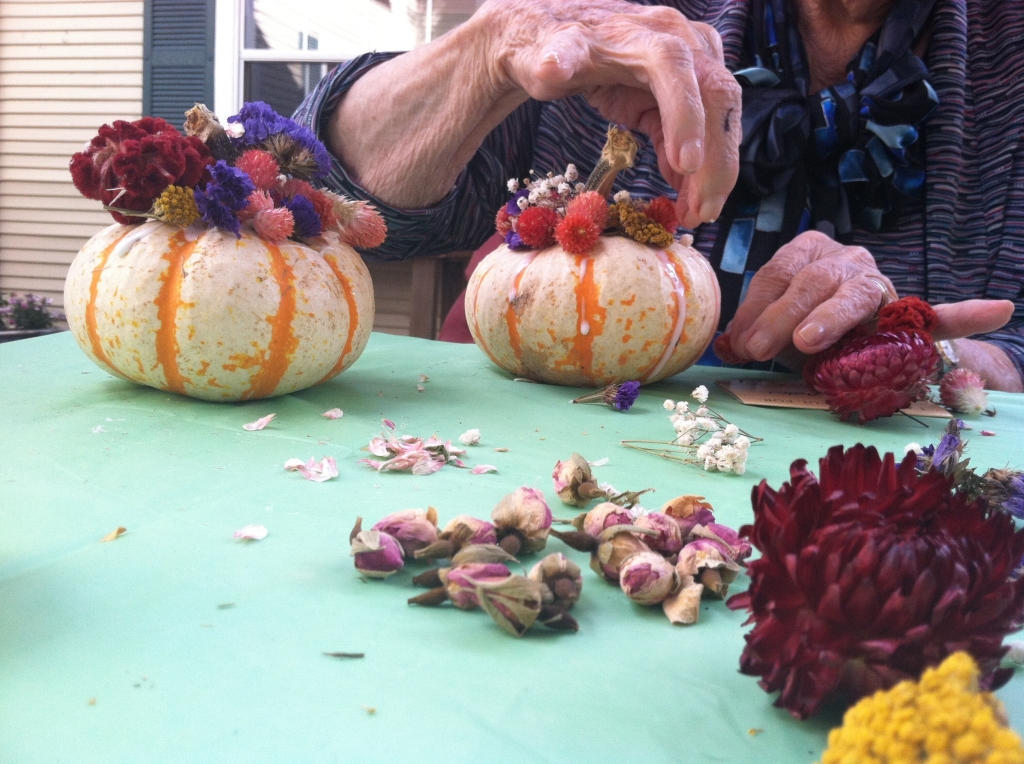 With the glue in place, begin placing flowers on the top of the pumpkin. There’s no rhyme or reason on how to apply flowers – just make it look pretty to your tastes.
With the glue in place, begin placing flowers on the top of the pumpkin. There’s no rhyme or reason on how to apply flowers – just make it look pretty to your tastes.
Apply additional glue as necessary to ensure all flowers have glue on them. (This is where I like to use Elmer’s glue since the tip of the bottle easily inserts between flowers to provide targeted glue application. If using craft glue, use a cotton swab to apply targeted globs of glue as needed.)
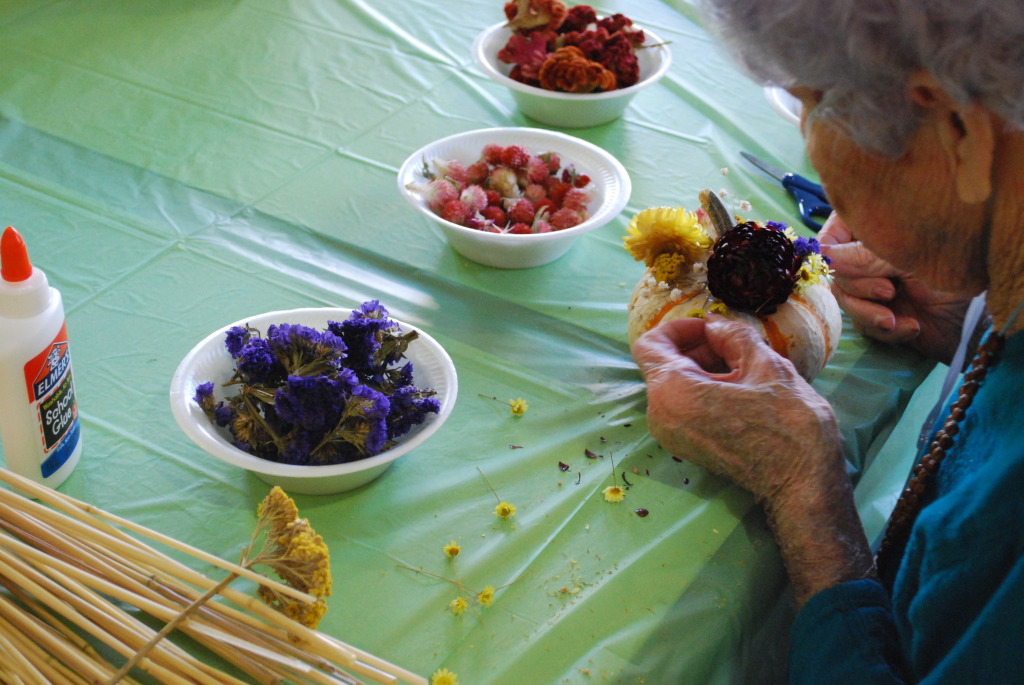 Keep applying flowers, rotating the pumpkin 360 degrees during application to ensure even coverage of flowers on all sides.
Keep applying flowers, rotating the pumpkin 360 degrees during application to ensure even coverage of flowers on all sides.
If attaching a decorative tag, write a quick note or greeting, inspirational quote, your name, or whatever on the tag.
Thread the wire through the hole in the tag.
Attach the wire to the pumpkin’s stem and secure in place. Voila!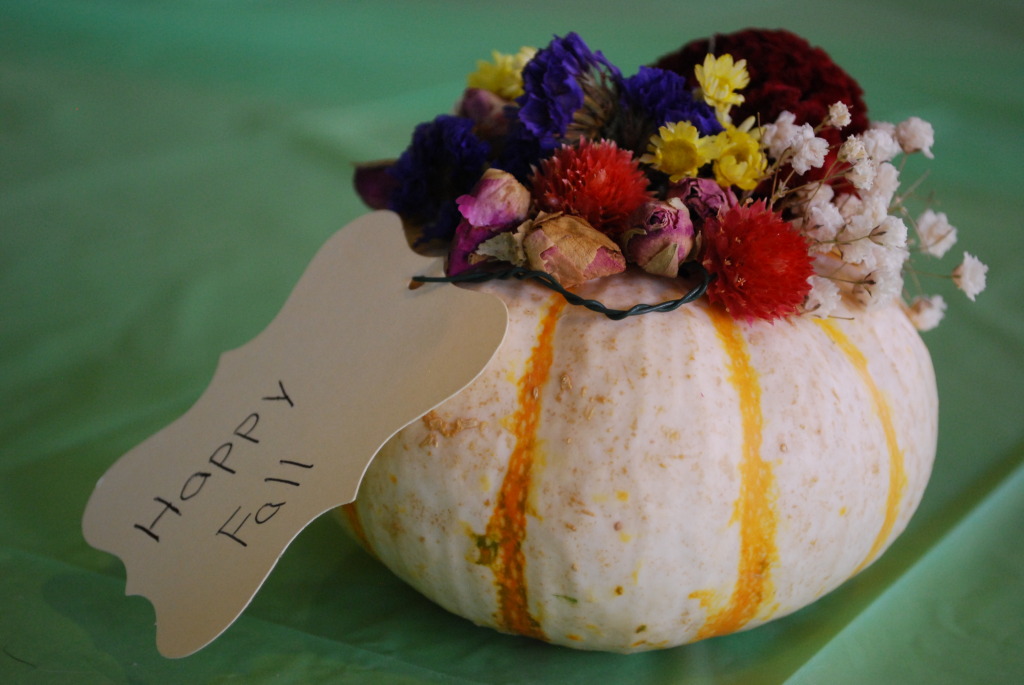
Notes for Horticultural Therapy Practitioners…
Aside from the changing colors of fall leaves, pumpkins provide a great seasonal cue to place clients in the time of year. To me, pumpkins represent autumn…and not just Halloween. I like blooming pumpkins as a season extending activity that’s appropriate to display all the way up to Thanksgiving. And, since I’m not able to easily use sharp knives or do pumpkin carving for safety and logistical reasons with most of my groups, this activity is an ideal option.
This is also an activity that can require more than one session for preparation, if you’re lucky enough to have an outdoor garden to utilize with a therapeutic horticulture program. One session can include the planting of annual flowers and perennials that are suitable for drying. Subsequent sessions include the maintenance and gradual harvesting of these flowers in the garden.
And did you know that pumpkins float in water?!? Oh, don’t get me started on that…
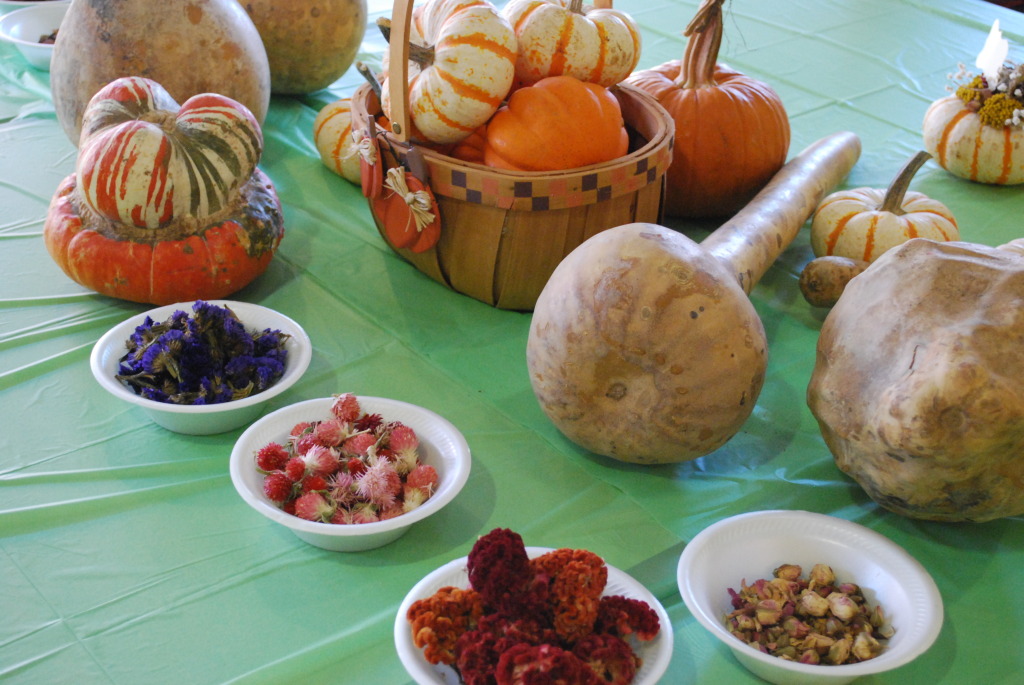 Contraindications
Contraindications
If you need to cut the dried flowers into smaller pieces, and you’re working with a group where sharp objects like scissors or pruners are potentially unsafe, here are a few tips to follow:
– Use child-safe scissors, not sharp scissors or pruners.
– Use flowers that are easy to pinch with the fingers. Be mindful of the level of the “ease of pinching,” in comparison to tolerance levels, for those who have fine motor issues.
– Pre-cut the stems off flowers and have them ready for use ahead of time.
Other potential issues:
When glue and flowers may be eaten by some individuals with cognitive challenges, use non-toxic options. Avoid putting flowers in bowls or other food-related objects.
Program Notes
Whenever I do this activity, I like to incorporate opportunities for clients to reminisce about their favorite holiday memories. So prior to doing the activity creations, we answer open ended questions about Thanksgivings past. For large groups, we break up into small groups and pass out pieces of paper with prompt questions. The groups identify a group leader and discuss their answers to the questions. After a few minutes, we gather back together and discuss the responses as a group.
Examples of prompt questions
– What is your favorite part of Thanksgiving?
– What are you are thankful for?
– What is your favorite food to eat on Thanksgiving?
Prompt questions inspired by JournalBuddies.com
Budget Buster Tips
– Grow your own flowers for drying. Harvest them throughout the season. Prep them and hang to dry until ready for use.
– Recycle flowers from old floral arrangements before discarding them. Baby’s breath, statice, and yarrow are examples. Whenever I do floral arranging programs throughout the year, I always use flowers that can be dried, and then harvest them from the old arrangements or leftovers after a program.
– Can’t afford pumpkins for each person? Get a handful of pie or Jack pumpkins, and have your group work in small teams to strategize and decorate a “community” pumpkin.
